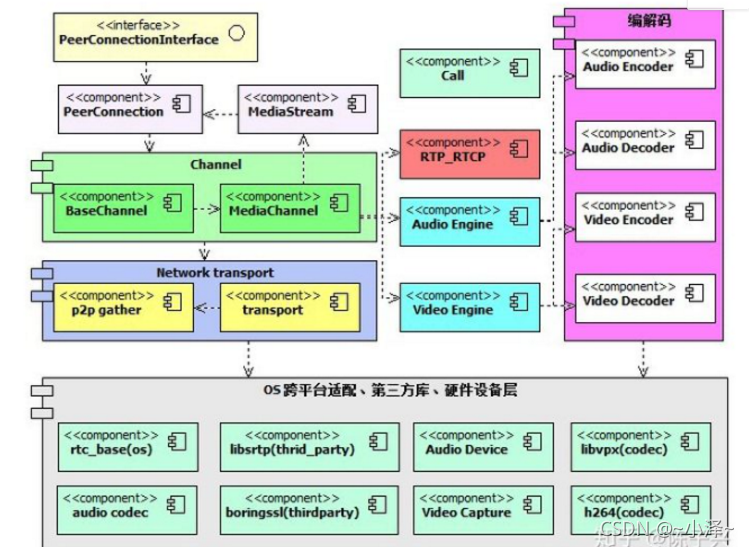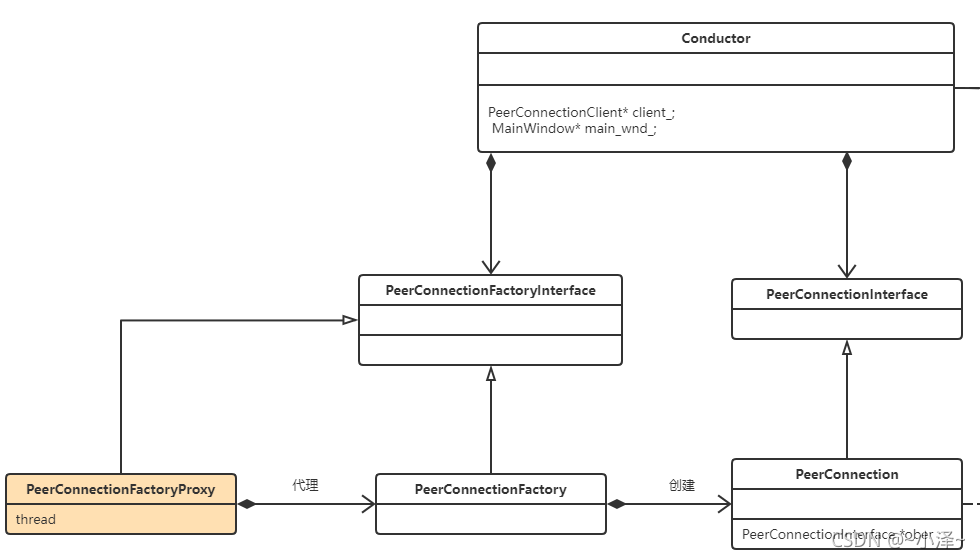创建PC
pc 是 peer connection 的简写,以下文章中pc 都特指 peer connection
PeerConnection 是webrtc 中链接过程非常重要的接口,提供了包括,链接、ICE、track、编解码流程控制
流程图
peer connection 的在整个框架中的位置

创建代码
- 1、创建PeerConnectionFactory 工厂
- 2、创建peer_connection
- 3、创建audio track 和 video track
bool Conductor::InitializePeerConnection() {
RTC_DCHECK(!peer_connection_factory_);
RTC_DCHECK(!peer_connection_);
//1. 创建PeerConnectionFactory 工厂
peer_connection_factory_ = webrtc::CreatePeerConnectionFactory(
nullptr /* network_thread */, nullptr /* worker_thread */,
nullptr /* signaling_thread */, nullptr /* default_adm */,
webrtc::CreateBuiltinAudioEncoderFactory(),
webrtc::CreateBuiltinAudioDecoderFactory(),
webrtc::CreateBuiltinVideoEncoderFactory(),
webrtc::CreateBuiltinVideoDecoderFactory(), nullptr /* audio_mixer */,
nullptr /* audio_processing */);
if (!peer_connection_factory_) {
main_wnd_->MessageBox("Error", "Failed to initialize PeerConnectionFactory",
true);
DeletePeerConnection();
return false;
}
//2. 创建peer_connection
if (!CreatePeerConnection(/*dtls=*/true)) {
main_wnd_->MessageBox("Error", "CreatePeerConnection failed", true);
DeletePeerConnection();
}
//3. 创建audio track 和 video track
AddTracks();
return peer_connection_ != nullptr;
}
1、创建PC工厂的过程
类图(PC工厂和 PC )

PC 工厂的创建
- 创建PeerConnectionFactory 工厂,调用的函数 webrtc::CreatePeerConnectionFactory,此方法将返回一个pc_connection,参数还是比较多,有10个之多。我们先看下在webrtc 中client 中的Conductor 的调用。
- 可以发现传入的参数,只有4个音视频codec 的工厂。其他的参数都为nullptr,后面我们会看下这些参数的作用
peer_connection_factory_ = webrtc::CreatePeerConnectionFactory(
nullptr /* network_thread */, nullptr /* worker_thread */,
nullptr /* signaling_thread */, nullptr /* default_adm */,
webrtc::CreateBuiltinAudioEncoderFactory(),
webrtc::CreateBuiltinAudioDecoderFactory(),
webrtc::CreateBuiltinVideoEncoderFactory(),
webrtc::CreateBuiltinVideoDecoderFactory(), nullptr /* audio_mixer */,
nullptr /* audio_processing */);
CreatePeerConnectionFactory 的定义,只是简单的函数封装,构建了PeerConnectionFactoryDependencies ,具体的含义等到后边会介绍
- 1、media engine ,参数包括:adm, 4个音视频 codec 工厂,audio_mixer, audio_processing ,7个参数都是由参数传入的。
- 2、创建call 工厂 ,不依赖参数
- 3、创建EventLog 工厂
- 4、构建dependence
- 5、传入dependence调用CreateModularPeerConnectionFactory
rtc::scoped_refptr<PeerConnectionFactoryInterface> CreatePeerConnectionFactory(
rtc::Thread* network_thread,
rtc::Thread* worker_thread,
rtc::Thread* signaling_thread,
rtc::scoped_refptr<AudioDeviceModule> default_adm,
rtc::scoped_refptr<AudioEncoderFactory> audio_encoder_factory,
rtc::scoped_refptr<AudioDecoderFactory> audio_decoder_factory,
std::unique_ptr<VideoEncoderFactory> video_encoder_factory,
std::unique_ptr<VideoDecoderFactory> video_decoder_factory,
rtc::scoped_refptr<AudioMixer> audio_mixer,
rtc::scoped_refptr<AudioProcessing> audio_processing) {
//1. 创建meida_engin,依赖7个参数
if (!audio_processing)
audio_processing = AudioProcessingBuilder().Create();
std::unique_ptr<cricket::MediaEngineInterface> media_engine =
cricket::WebRtcMediaEngineFactory::Create(
default_adm, audio_encoder_factory, audio_decoder_factory,
std::move(video_encoder_factory), std::move(video_decoder_factory),
audio_mixer, audio_processing);
//2. 创建call 工厂
std::unique_ptr<CallFactoryInterface> call_factory = CreateCallFactory();
//3. 创建EventLog 工厂
std::unique_ptr<RtcEventLogFactoryInterface> event_log_factory =
CreateRtcEventLogFactory();
//4. 构建dependence
PeerConnectionFactoryDependencies dependencies;
//4.1 传参设置
dependencies.network_thread = network_thread;
dependencies.worker_thread = worker_thread;
dependencies.signaling_thread = signaling_thread;
//4.1 有上面1-3步进行创建
dependencies.media_engine = std::move(media_engine);
dependencies.call_factory = std::move(call_factory);
dependencies.event_log_factory = std::move(event_log_factory);
//5. 传入dependencies 创建PC Factory
return CreateModularPeerConnectionFactory(std::move(dependencies));
}
CreateModularPeerConnectionFactory 的实现
- 1、创建pc_factory,参数dependencies
- 2、调用PeerConnectionFactory::Initialize,需要同步调用,但是需要要求在signaling_thread(信令线程)执行,等待执行结果使用到跨线程同步执行。跨线程可参考 webrtc源码








 最低0.47元/天 解锁文章
最低0.47元/天 解锁文章
















 1349
1349

 被折叠的 条评论
为什么被折叠?
被折叠的 条评论
为什么被折叠?








